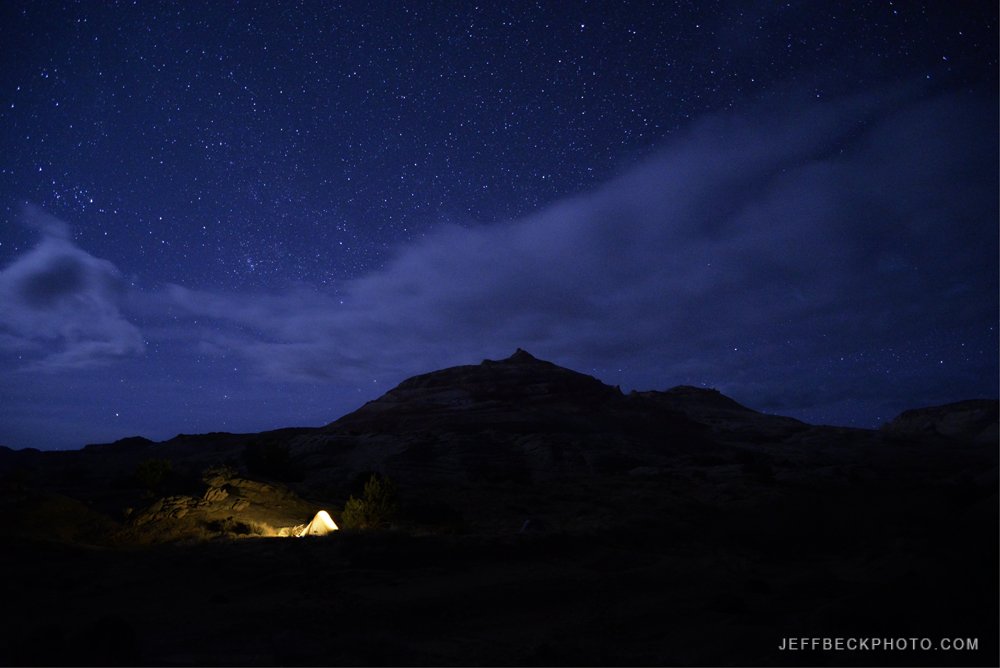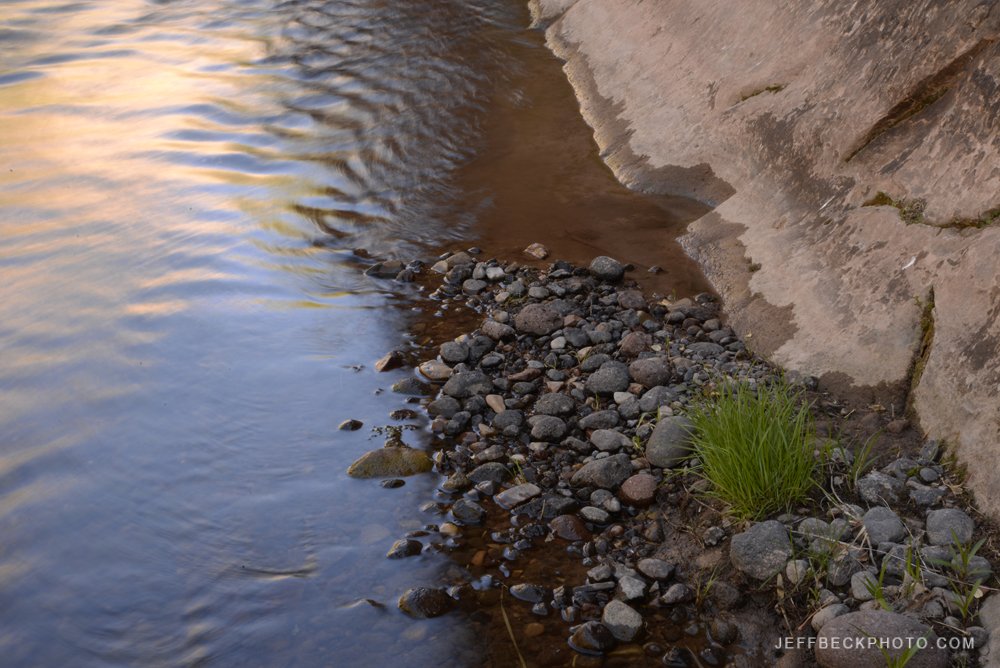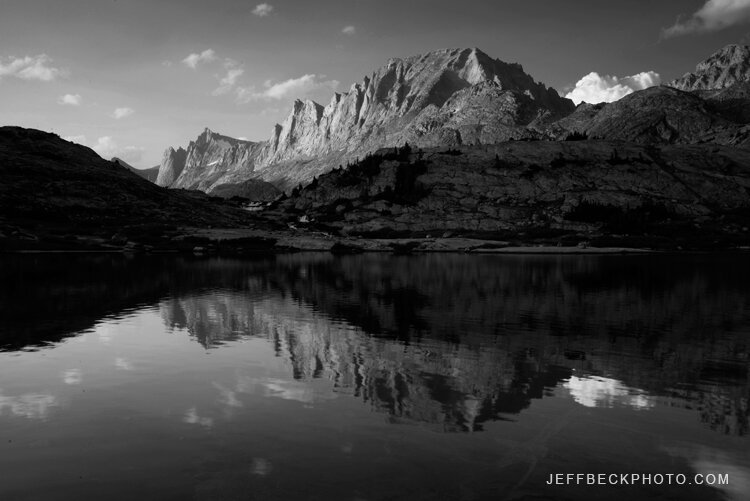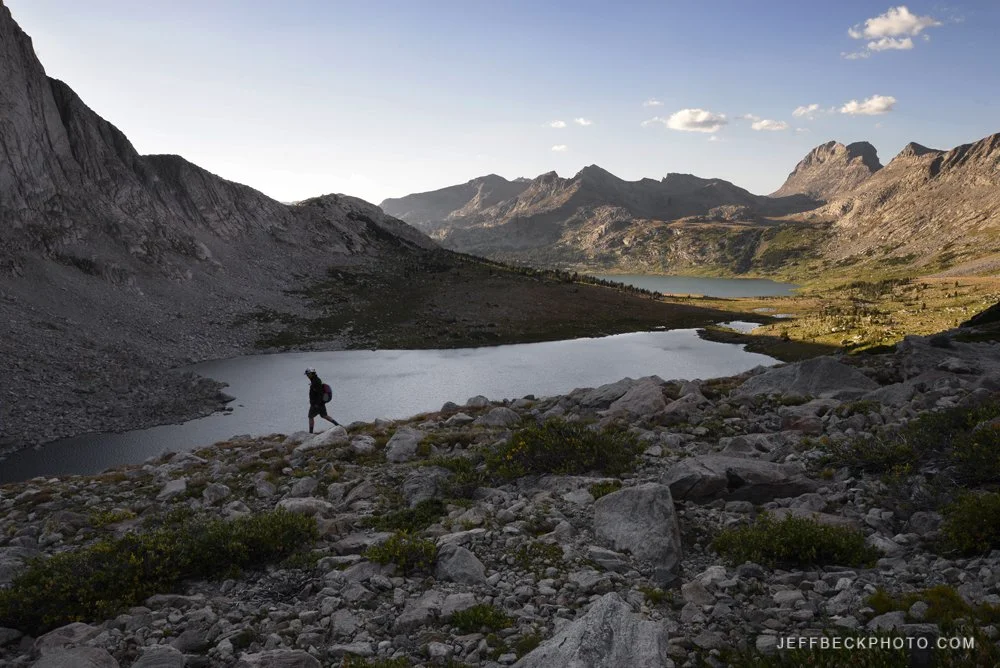Looking at these photos in December, I’m less disappointed with them than I was in April. As the intensity of the moment fades from my memory, from the tiny scorpion hanging out in the sand at the door of my tent, to the bite of a chill wind and even a few snowflakes, to the exhaustion of hours of cross-country travel, clamoring over slickrock ridges and across deep sand plains, to the dizzying ledges and walls that looked too steep to walk on, the images become better surrogates of the experience.
Wind River Range: August 2020
EB hikes beside upper Titcomb Lake, Bridger Wilderness, Wyoming
I was lucky enough to spend seven days backpacking in the Winds in late August. Making it back in to Titcomb Basin after 20 years was a highlight. As was being back in the Wind River Range with Erik and Rosalie three years after our first trek together there. August twenty years ago was my first backpack in the Winds. This was my fifth. I’m hoping to increase that frequency over the next twenty years.
Our route went from Elkhart Park past Senaca Lake and Island Lake to Titcomb Basin then back to the Highline Trail which we followed over Lester Pass and down to the Cook Lakes Loop. One of the highlights of the trip was hiking to Wall Lake from our camp at Upper Cook Lake. We finished our loop on the Pole Creek Trail past Eklund Lake and back past Photographers Point to Elkhart Park.
Titcomb Basin and vicinity was a zoo. The scenery is undeniable but at times the amount of traffic on the trail was noisy and annoying. We found a gorgeous campsite at the end of a string of lakes below Titcomb Lakes. When we got there there was one other group and we tried to give them a little room and still stay legal by not camping too close to the outlet stream. We turned around and two more groups had moved in, one on either side of us.
On the other side of Lester Pass we finally got a little solitude. It seemed like there were only two other groups in the entire Cook Lakes area while we were there. On two jaunts to Wall Lake, one in the evening by myself and then again in the morning with Erik, we didn’t see another soul.
I loved almost everything about this trip except the light. On day three thick smoke from distant wildfires filled the range and never fully cleared. Looking at my photos from our second evening, and my most productive landscape photo session of the trip, the air was already less than clear. This definitely forced me to concentrate on details which was not necessarily a bad thing. I’ve come home from many a trip to look at my photos and think, I wish I would have focused more on details instead of trying to get everything in the frame all the time.
Some of my favorite images of the trip and certainly the most colorful were of butterflies. There were a ton of butterflies flitting around high wildflower meadows. The Fritillaries were particularly abundant, but the California Tortoiseshells were the most approachable.
Fremont Peak reflected in a small lake below Titcomb Basin, Wind River Range, Wyoming
Scanning 35mm Film
As I’ve been working on the new website, I realized that some of my older film scans were not migrated to newer hard drives. When I first started scanning my film, I made the mistake of scanning a lot of images at smaller sizes because I was trying to save hard drive space, and I didn’t want to clutter up my drives with full size images (100+MB) that weren’t ultimately going to be printed large.
Today, my hard drives are full of images that will never even be proofed - because they’re not good enough. With digital storage costing less than ever, it only makes sense to scan film at the highest possible resolution, creating a master image file that is sized down for proofing, instead of scanning a proof size file and rescanning if a larger file is desired, which is what I used to do.
So, rather than trying to retrieve the digital versions, I’ve been rescanning some of my 35mm slides. Images from my previous website galleries; praiseworthy images that slipped through the cracks because they're not core portfolio images. I’ve also been scanning some images that had never been transferred to digital. This has made me realize a few things.
First, I need to be more diligent with the organization and updating of my digital image library. Not migrating digital content to new media or new technology could have catastrophic consequences when there’s no hard copy original to fall back on.
Second, I have a huge collection of images on film that have rarely if ever been seen. Images that were once projected in slide shows, but have never existed in digital form, yet still deserve some attention. I need to resume scanning my best chromes, something I stopped doing once I became firmly established in my digital workflow.
Third, I should offer my services to people who want to give new life to images on film. I could put my Nikon Coolscan to work. So, if you have precious images on 35mm film (slide or negative) that you’d like to convert to jpeg and tiff, contact me to find out how.






























